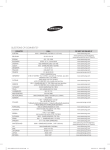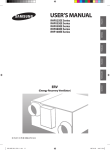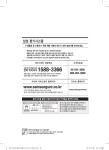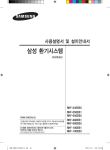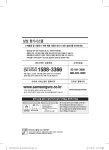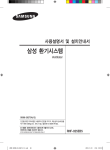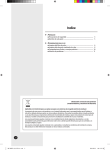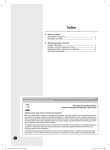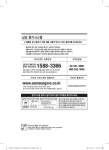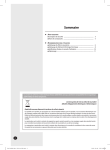Download Samsung RHF100EE Installation manual
Transcript
ENGLISH INSTALLATION MANUAL DEUTSCH PORTUGUÊS ITALIANO FRANÇAIS ESPAÑOL RHF025EE Series RHF035EE Series RHF050EE Series RHF080EE Series RHF100EE Series ERV (Energy Recovery Ventilator) E S F I P D DB98-27512A(3) RHF025EE_IM_E_27512-3.indd 31 2008-10-22 ソタネト 1:48:01 Contents PREPARATION Safety Precautions ......................................................................................................... Space Requirements .................................................................................................... Installation Diagram ..................................................................................................... External Dimension ...................................................................................................... 3 5 7 8 INSTALLING THE UNIT Installing the Unit .......................................................................................................... Electric Wiring ................................................................................................................. Schematic Diagram ...................................................................................................... Option Switches ............................................................................................................. Connecting the Unit ..................................................................................................... 10 11 14 15 16 COPMPLETING THE INSTALLATION Duct Connection ........................................................................................................... 26 Performance Graph ...................................................................................................... 27 Final Checks and Trial Operation ............................................................................ 29 E-2 RHF_025EE_IM_E_27512_1.indd 2 2007-04-18 ソタネト 5:43:26 ENGLISH Safety Precautions Keep this installation manual together with the user’s manual in a handy place so that you can find it whenever you need to see it after reading this manual thoroughly. Make sure to read the following safety precautions carefully before installation. Make sure to observe the cautions specified in this manual. Conduct a test run of the unit after installation and then explain all system functions to the owner. The indications and meanings are as shown below. WARNING This indicates the possibility of serious injury or death. Do not install the unit by yourself. Incorrect installation of the unit could cause injury due to fire, electric shock and water leakage or from the unit falling. Consult a dealer or a qualified installer. Hang down a blockage for bird in front of outdoor air suction duct. If something such as bird’s nest blocks the air suction duct, it may result in oxygen shortage in indoors. Perform the installation securely referring to the installation manual. Incomplete installation could cause personal injury due to fire, electric shock or the unit falling. Do not attempt to repair, move, modify or reinstall the unit on your own. Make sure that these installations are carried out by qualified personnel to avoid electric shock or fire. Check if the voltage and the frequency of the main power supply are required for the unit to be installed and check the connection. The electric work must be done by service agent or similarly qualified person according to national wiring regulations and use only rated cable. If the capacity of the electric work is not properly completed, electric shock or fire may occur. Make sure the air intake is located far from an exhaust port of a burner. It may cause oxygen shortage. Ground the unit. Do not connect the ground to a gas pipe, water pipe, lighting rod or telephone grounding. Defective grounding could cause electric shock. Install the cables with supplied cables firmly. Fix them securely so that external force is not to exert to the terminal board. If the connection or fixing is incomplete, heat generation, electric shock or fire may occur. If the power plug is damaged, replace it by the manufacturer or qualified personnel to avoid the risk. Disconnect the circuit breaker when you don’t use the product for a long period of time to save energy. Do not install the electric wire to get tension to avoid a hazard. Unplug the product before get repaired. Do not pull the electric wire or touch the power plug with wet hands. Installers are required to read the general information carefully for safety. Do not put the product near dangerous substances to prevent fire, explosion or injury and do not expose the product to direct sunlight. Install separate MCCB and ELB when installing the power cable. If you do not install the MCCB and ELB, electric shock or fire may occur. E-3 RHF_025EE_IM_E_27512_1.indd 3 2007-04-18 ソタネト 5:43:26 WARNING This indicates the possibility of serious injury or death. Avoid the use of an extension cord and do not share the power outlet with other appliances. Incomplete connection, defective insulation or exceeding the permissible current may cause electric shock or fire. CAUTION Make sure to turn off the main power when setting up the product’s electric circuit or power cords. There is electric shock. The product should be Ensure that the national safety code requirements have been followed for the main supply circuit. Ensure that a properly sized and connected ground wire is in place. installed in accordance with the National Electrical regulations. This indicates the possibility of serious injury or damage to environments when operated incorrectly. Install the unit in a place where it is strong enough to hold the product weight. When installed in place where it is not strong enough to withhold the product weight, the unit may fall and cause injury. Install the product inside heat insulation over the ceiling not to be contacted with the outside air. If the product is installed out of the insulation, it may result in electric shock or malfunction due to moisture generated in the product. Do not install the product in a place where it is exposed to inflammable gas leakage. Do not install the product in humid place such as bathroom. It may cause electric shock or malfunction. Make sure to use the part All of the manufacturing and Do not install the product Dispose of the packaging provided or specified parts for the installation work. The use of defective parts could cause injury, fire, electric shock or the unit falling, etc. in the place where exposed to sulfurous acid or steam because it may damage the parts or cause malfunction. Do not install the product in the place where generates toxic gas such as chemical factory. It may cause fire or gas poisoning. Check the product for damage that may have taken place during transportation and do not install or use damaged equipment. packaging material used for your new appliance are compatible with the environment and can be recycled. material in accordance with the local requirements. Install a ground leakage breaker depending on the installation place (where it is humid). If not, it may cause electric shock. The product must be installed according to the national electrical regulations. The maximum input power and current is measured according to the IEC Standard and the input power and current is measured according to ISO standard. E-4 RHF_025EE_IM_E_27512_1.indd 4 2007-04-18 ソタネト 5:43:27 ENGLISH Space Requirements 025 600mm Exhaust Air Body Outdoor Air Heat exchange element Inspection hole (for filter, heat exchange element, fan, motor and damper) Supply Air Return Air The ventilator should be installed in a ceiling which has enough space above as seen in the picture. E-5 RHF_025EE_IM_E_27512_1.indd 5 2007-04-18 ソタネト 5:43:27 Space Requirements (Continued) 035/050/080/100 'A'mm Return Air Body 'B'mm Supply Air Space for repairing Inspection hole (for filter, heat exchange element, fan, motor and damper) Exhaust Air Outdoor Air Heat exchange element Model 'A' 'B' 035/050 1000 600 080/100 1135 800 Number of heat exchange elements 2 The ventilator should be installed in a ceiling which has enough space above as seen in the picture. Model 'A' 035/050 320 080/100 440 E-6 RHF_025EE_IM_E_27512_1.indd 6 2007-04-18 ソタネト 5:43:27 ENGLISH Installation Diagram 025 Exhaust Air duct Supply Air duct Anchor bolt Supply Air Hood Air discharging hole (Air exhaust grille) Return Air Air intake hole (Air exhaust grille) Exhaust Air Insulation Return Air duct Outdoor Air suction duct Hood 035/050/080/100 Supply Air duct Exhaust Air duct Anchor bolt Supply Air Hood Air discharging hole (Air exhaust grille) Return Air Air intake hole (Air exhaust grille) Outdoor Air Insulation Return Air duct Outdoor Air suction duct Hood CAUTION Install the unit in a place where it is strong enough to hold the product weight. Install the unit in a place where the space is enough to install or repair the unit. Do not install the unit in humid place such as bathroom. Do not install the unit in a place over 40°C or where exposed to fire, gasoline or smoke directly. Install the cables with supplied ones securely. E-7 RHF_025EE_IM_E_27512_1.indd 7 2007-04-18 ソタネト 5:43:28 External Dimension 025 Outdoor Air Return Air Exhaust Air Supply Air Nominal diameter for duct : Ø150mm No. Name Quantity Maintenence cover 1 Heat exchange element 1 Dust filter 2 Hanger 4 Electrical component box 1 (Unit : mm) Model A B C E F G H I J K M N P Q R 025 600 660 70 510 675 729 102 470 85 98 242 Ø140 Ø156 133 350 Ensure the space for installing and repairing. E-8 RHF_025EE_IM_E_27512_1.indd 8 2007-04-18 ソタネト 5:43:28 ENGLISH 035/050/080/100 Exhaust Air Return Air Outdoor Air Supply Air (Unit : mm) No. Name Quantity Maintenence cover 1 Heat exchange element 2 Dust filter 4 Hanger 4 Electrical component box 1 Model Nominal diameter for duct 035/050 Ø200 080/100 Ø250 (Unit : mm) Model A B C E F G H 035/050 1000 1012 99 940.6 1036.4 26 130 080/100 1135 1220 84 1110 1183 I J 617 253 K M N P 135 270 Ø194 Ø241.5 25 184 613.25 387.75 170 340 Ø244 Ø270 Ensure the space for installing and repairing. E-9 RHF_025EE_IM_E_27512_1.indd 9 2007-04-18 ソタネト 5:43:28 Installing the Unit Make sure to attach the unit firmly. If the unit is not attached firmly or attached incorrectly, it may result in malfunction or injury. 1 Insert bolt anchors to a ceiling. Use existing ceiling support or construct a suitable support. 2 Install the suspension bolts depending on the ceiling type. 3 Screw two nuts to the suspension bolts making space for hanging the unit. 4 Hang the unit horizontally to the suspension bolts between two nuts. 5 Fasten the nuts to suspend the unit. The washer should be fit for the hanger. Nut Washer Rubber Hanger Rubber Washer Nut Nut Suspension bolt (Ø10~Ø12) Fasten the nut CAUTION Ensure that the ceiling is strong enough to support the weight of the unit. Before hanging the unit, test the strength of each attached suspension bolt. E-10 RHF_025EE_IM_E_27512_1.indd 10 2007-04-18 ソタネト 5:43:29 ENGLISH Electric Wiring Before electric wiring, make sure that the voltage is 1 wire 220V/50Hz. Electrical Component Box Surface 035/050/080/100 025 Maintenance cover Hanger Fixing part of wires Electrical component box Maintenance cover Hanger Electrical component box Fixing part of wires Inside Wiring outlet Transmitter PBA Grounding E-11 RHF_025EE_IM_E_27512_1.indd 11 2007-04-18 ソタネト 5:43:30 Electric Wiring (Continued) Electric Wiring Connect to ERV wired remote control Fixing part of electrical wires Connect to power supply wire Compressed ring terminal Cable Screw Electrical component box Screw 1 Remove the 4 screws on the electrical component box and open the cover plate. 2 Connect the cables correctly as seen in the picture. Fix the cables with a cable tie. 3 Connect the cable to the terminal board with a compressed ring terminal. Fix the screws in the electrical component box with designated torque referring to the table. Size Recommended size Maintenence cover Electrical component box M5 Bolt M6 Bolt N·m 1.34~2.0 1.67~2.5 kgf·cm 13.4~20.0 16.7~25.0 Cable fixation CAUTION Do not wash the heat exchange element. It may decrease the efficiency. Make sure to use rated cable for power supply and do not extend or cut the cord. The unit should be installed in accordance with the National Electrical regulations. Ensure that the national safety code requirements have been followed for the main supply circuit. E-12 RHF_025EE_IM_E_27512_1.indd 12 2007-04-18 ソタネト 5:43:31 ENGLISH Main PCB ① ② ③ ④ ⑤ ⑥ ⑦ ⑧ ⑨ ⑩ ⑪ No. Classification Explanation Specifications 1 DISPLAY DISPLAY 2 CO2 sensor CO2 sensor connection port 3PIN (CN43) 3 Temperature sensor Indoor/outdoor temperature sensor connection port 4PIN (CN41) 4 Damper switch Signal input port of damper switch 3PIN (CN51) 5 External control On/Off control by external contact signal 2PIN (EXT1) / 2PIN (EXT2) / 2PIN (EXT3) 6 ERV wired remote control V1, V2 (DC 12V power supply), F3,F4 (ERV wired remote control communication) 4PIN (TB±COM) 7 Communication F1, F2 (Communication between the ventilators or transmitter) 2PIN (TB±COM) 8 Monitor the operation status Report operation errors 4PIN (CN77) 9 Damper motor Damper control port for changing operation modes 2PIN (CN72) 10 External device External humidifier/ External damper 4PIN (TB±LOAD) 11 Power supply 220V/50Hz(L/N) 2PIN (TB±LOAD) E-13 RHF025EE_IM_E_27512-2.indd 13 2008-02-13 ソタタ・9:43:53 Schematic Diagram 025/035/050 080/100 Power and Communication cables specification Power Cable Communication Cable 2.0mm2(CV) 0.75mm2(VCTF) (----) indicates Installation specification in the field. The power and communication cables are not supplied with air conditioner. E-14 RHF025EE_IM_E_27512-3.indd 14 2008-10-22 ソタネト 1:48:03 ENGLISH Option Switches The default setting of all switches is ON. If you want to set the function on, turn OFF the switch. DIP Switch SW05 SW06 Function ON OFF K5 Spare - - K6 Centralized control Not use Use K7 Spare - - K8 MASTER/SLAVE SLAVE MASTER K9 CO2 sensor Not use Use K10 Filter signal display 2000 Hr 1000 Hr K11 External control K12 SW07 SW05 K5 K6 K7 K8 SW06 SW07 K9 K10 K11 K12 K13 K14 K15 K16 Refer to the table below K13 External humidifier Not use Use K14 Spare - - K15 External damper Not use Use K16 Spare - - K5 (Spare) K6 (Centralized control) ON: Not use of centralized controller OFF: Use of centralized controller K7 (Spare) K8 (MASTER/SLAVE) ON: Communicate COM1(F1, F2), operating as SLAVE OFF: Communicate COM2(F1, F2), operating as MASTER K9 (CO2 sensor) ON: Not use of external CO2 sensor OFF: Use of external CO2 sensor K10 (Filter signal display) ON: Display filter reset after 2000 of running hours OFF: Display filter reset after 1000 of running hours K11, K12 (External control) Setup control level of the ERV wired remote control and external control K13 (External humidifier) ON: Not use of external humidifier OFF: Use of external humidifier K14 (Spare) K15 (External damper) ON: Not use of external damper OFF: Use of external damper K16 (Spare) K11, K12 (External control) K11 K12 External control setup Same level control with the ON ON ERV wired remote control and external control (Followed by the last control status.) Priority to the ERV wired remote control (While operating by the ERV remote control, it can ON OFF wired not be controlled by the external control. The external control is possible only when the ventilator is turned off.) Priority to the external control (While operating by the external control, it can not be controlled by the ERV wired OFF ON remote control. The ERV wired remote control can control only when the ventilator is turned off.) OFF OFF Not use E-15 RHF025EE_IM_E_27512-2.indd 15 2008-02-13 ソタタ・9:43:56 Connecting the Unit Make sure to disconnect the power cable and power supply before connecting the ventilator to other control solutions. If not, it may cause malfunction due to electrical interference. Transmitter It does not need to connect the transmitter in case of individual control. Connect the transmitter to the MASTER ventilator only, in case of centralized control. Transmitter 1 Attach the transmitter to the case in the electrical component box. 2 Connect the V1, V2 terminal of the transmitter to the V1, V2 terminal of the ventilator PCB. (DC 12V) 3 Connect the F1, F2 terminal of the transmitter to the F1, F2 terminal of the ventilator PCB. (COM1 Communication) Ventilator ERV Wired Remote Control ERV Wired Remote Control Ventilator 1 Remove the maintenence cover of the ERV wired remote control. 2 Connect the V1, V2 terminal of the ERV wired remote control to the V1, V2 terminal of the ventilator PCB. (DC 12V) 3 Connect the F1, F2 terminal of the transmitter to the F1, F2 terminal of the ventilator PCB. (COM2 Communication) 4 Reassemble the maintenence cover and the ERV wired remote control. E-16 RHF_025EE_IM_E_27512_1.indd 16 2007-04-18 ソタネト 5:43:44 ENGLISH ERV Wired Remote Control and Multiple Ventilators ERV Wired Remot Control COM2 (F3, F4) DC 12V (V1, V2) Ventilator Ventilator Ventilator 1 Remove the maintenence cover of the ERV wired remote control. 2 Connect the V1, V2 terminal of the ERV wired remote control to the V1, V2 terminal of the ventilator PCB. (DC 12V) 3 Connect the F3, F4 terminal of the transmitter to the F3, F4 terminal of the each ventilator PCB. (COM2 Communication) 4 Reassemble the maintenence cover and the ERV wired remote control. Ventilator The ERV wired remote control is MASTER of COM2 communication, so it can communicate without separate ADDRESS setting. Up to 16 ventilators can be connected to a ERV wired remote control at once. E-17 RHF_025EE_IM_E_27512_1.indd 17 2007-04-18 ソタネト 5:43:44 Connecting the Unit (Continued) Centralized Controller Installing the Centralized Controller SW05 MAIN SW01 ADDRESS RMC SW02 ADDRESS To use a centralized controller, set K6 of SW05 to OFF position. -To centralized control, the ventilator should be set as MASTER among one or more ventilators for communication. K5 K6 K7 K8 Setup Master Ventilator Centralized Controller Master Ventilator MAIN:0 RMC:0 Ventilator MAIN:1 RMC:1 Ventilator MAIN:2 RMC:2 Transmitter Indoor unit RMC ADDRESS 1 2 3 4 5 6 7 8 9 A B C D E F Number on the centralized controller 1 2 3 4 5 6 7 8 9 10 11 12 13 14 15 SW05 MAIN SW01 RMC SW02 ADDRESS ADDRESS K5 K6 K7 K8 1 Set K8 of SW05 to OFF position. 2 Set MAIN ADDRESS as 0,1,2 and also set RMC ADDRESS as 0,1,2 as well. MAIN : Setup switch to designate the address among ventilators RMC : Setup switch to designate the address when controlling by a centralized controller E-18 RHF_025EE_IM_E_27512_1.indd 18 2007-04-18 ソタネト 5:43:46 ENGLISH Setup the Centralized Controller Setup the Centralized Individual Control (1:1, Individual Room Control) To centralized individual control, set each of the RMC ADDRESS of each ventilator to different number which is controlled by a centralized controller. Centralized Controller Transmitter 0 Master Ventilator MAIN:0 RMC:0 Ventilator Ventilator Ventilator Ventilator MAIN:1 RMC:1 MAIN:2 RMC:2 MAIN:3 RMC:3 MAIN:4 RMC:4 Transmitter 1 Master Ventilator Ventilator Ventilator Ventilator Ventilator MAIN:0 RMC:5 MAIN:1 RMC:6 MAIN:2 RMC:7 MAIN:3 RMC:8 MAIN:4 RMC:9 If the 00 switch of the centralized controller is set to ON position, the ventilators which are designated 0 of their RMC ADDRESS are operated. E-19 RHF_025EE_IM_E_27512_1.indd 19 2007-04-18 ソタネト 5:43:48 Connecting the Unit (Continued) Setup the Centralized Control (Continued) Setup the Centralized Group Control (1:1 group, 16 Groups Control) To centralized group control, set all of the RMC ADDRESS of all ventilators to be controlled as the same number which is controlled by the centralized controller. Centralized Controller Transmitter 0 Master Ventilator MAIN:0 RMC:0 Ventilator Ventilator Ventilator Ventilator MAIN:1 RMC:0 MAIN:2 RMC:0 MAIN:3 RMC:0 MAIN:F RMC:0 Transmitter F Master Ventilator Ventilator Ventilator Ventilator Ventilator MAIN:0 RMC:F MAIN:1 RMC:F MAIN:2 RMC:F MAIN:3 RMC:F MAIN:F RMC:F If the 00 switch of the centralized controller is set to ON position, 16 ventilators which are set as 0 of their RMC ADDRESS are operating simultaneously. Up to 256 of ventilators can be controlled at once. E-20 RHF_025EE_IM_E_27512_1.indd 20 2007-04-18 ソタネト 5:43:50 ENGLISH Setup Simultaneous Control of Centralized Controller and the ERV Wired Remote Control The centralized controller can be controlled by RMC ADDRESS of the ventilator, while the ERV wired remote controller is controlled by COM2 communication. Centralized Controller Master Ventilator MAIN:0 RMC:0 COM1 (F1, F2) Transmitter 0 ERV Wired Remote Control Ventilator Ventilator Ventilator MAIN:1 RMC:0 MAIN:2 RMC:0 MAIN:3 RMC:0 COM2 (F3, F4) Ventilator MAIN:F RMC:0 The ERV wired remote control is MASTER of COM2 communication, so it can communicate without separate ADDRESS setting. Level Setup of Centralized Controller You can control the ventilator in multiple ways with DIP switch (DS01) setting on the centralized controller. DIP Switch SW01 SW02 SW03 SW04 LEVEL 0 OFF OFF OFF OFF The ventilator operates with the last used control solution LEVEL 1 ON OFF OFF OFF When the centralized controller is OFF: You can not use wired/wireless remote control. When the centralized controller is ON: You can use wired/wireless remote control. LEVEL 2 OFF ON OFF OFF The ventilator operates only with the centralized controller. OFF If the On/Off button is pressed once : The operation indicator is turned on. The ventilator is on standby. The ventilator operated with wired/wireless remote control. If the On/Off button is pressed twice: The operation indicator is turned off. You can not operate the ventilator with wired/wireless remote control. LEVEL 3 ON ON OFF Remark E-21 RHF_025EE_IM_E_27512_1.indd 21 2007-04-18 ソタネト 5:43:52 Connecting the Unit (Continued) External Control Use an external control to control the ventilator with separate machinery or external contact point. External control 1 External control 2 Connect both sides of EXT1(EXT2 or EXT3). - Up to 3 units can be connected at once. - The picture displays the condition that 2 external controllers are connected. If the external controller 1 or 2 are set to ON position, ventilator is operated in the last used condition. EXT3 EXT2 EXT1 Connect to Report the Operation Condition Use this function to check out the operation condition or errors of the ventilator. Make sure that the current which flows through terminal should not exceed 0.5A. Report errors External power supply Lamp Install a lamp to check the operation condition to the ON/OFF output terminal. - If the ventilator is turned on/off, the lamp is turned on/off followed by the ventilator. Lamp External power supply Report On/Off condition Connecting External Device Connect to use humidifiers and dampers with the ventilator. DAMPER SW07 HUMID K13 K14 K15 K16 Turn off the option switch to use, - K13: The use of humidifiers - K15: The use of dampers COMMON If the ventilator is operated, the external damper is operated as well if it had been installed. Make sure that the current is not exceed to 0.5A. When you connect DAMPER an external device over 0.5A, use an extra terminal relay. E-22 RHF025EE_IM_E_27512-2.indd 22 2008-02-13 ソタタ・9:43:56 ENGLISH Trial Operation Press the trial operation button. - Press the trial operation button one more time to turn it off. is displayed on DIS1. - While operating the trial operation, - Check if the communication between the ventilator and the ERV wired remote control is normal if they are connected. If the ERV wired remote control is correctly connected, flickers on the first DIS1. - If multiple ventilators are connected, set at least one of the K8 to OFF position to set as MASTER. Check out the communication to see the display. DIS1 DIS2 Display SLAVE’s MAIN ADDRESS when set as MASTER and display RMC ADDRESS of itself when set as SLAVE. Display SLAVE’s MAIN ADDRESS when set as MASTER and display MAIN ADDRESS of itself when set as SLAVE. Display when set as MASTER, Display when set as SLAVE flickers when connected with the ERV wired remote control What is Constant Air Volume Control If the dust resistance is under 'A', the a is over 'B'. Therefore, due to excessive increased air volume, the noise and energy load are bound to increase. Control the constant air volume to maintain the 'B' air volume even in case that the duct resistance is set low. - Constant air volume control is recommended when the power supply is stable 200~240V. - To operate constant air volume control, press K2 button. - Constant air volume control remains for 20 minutes. After 20 minutes, it is turned off automatically. - To stop the constant air volume control, press K2 button again. You should start over the constant air volume control again. - While the constant air volume control is operated, remain time and K2 flickers on the display panel. K2 Remaining operation time Model 'A' (mmAq) 'B' (CMH) 025 035 050 080 100 12 17 17 17 18 250 350 500 800 1000 Error Code Display Error Code Explanation Classifications Indoor temperature sensor (Short/Open) Outdoor temperature sensor (Short/Open) Sensor error CO2 sensor (Short/Open) Supply Air fan motor error Exhaust Air fan motor error Fan error Tracking error of MASTER ventilator (After 5 times of tracking, SLAVE ventilators can not be detected.) System failure by communication error after tracking Communication error by installing COM1 Dual MASTER Communication error between the wired remote control and the ventilator (When the communication is interrupted for 3 minutes) COM1/COM2 cross installation error EEPROM error Damper error (When there is no switch input for 100 seconds while monitoring the damper) Communication error Others indicate errors due to ERV wired remote control. Refer to the ERV wired remote control installation manual. E-23 RHF_025EE_IM_E_27512_1.indd 23 2007-04-18 ソタネト 5:43:56 Connecting the Unit (Continued) Centralized Controller Trial Operation Before operating the trial operation, make sure that the ventilator and the transmitter are operating correctly. 1 Check power cord (L,N) and communication cable (R1, R2). 2 Check the power of the ventilator and the centralized controller. 3 If the power is supplied, the centralized controller operates tracking to check connected ventilators and transmitter. The LED(Red) on the centralized controller flickers after starting the tracking. The LED(Red) on the centralized controller still flickers after completing the tracking. Check the completion of tracking by pressing all room ON/ OFF button after a minute. If you reset the setting in other way, disconnect the power of the centralized controller and reset the DS01. And turn the power on again. Check the reset LEVEL by setting all room ON/OFF button to OFF position. If you do not turn on the centralized controller again, you can use it with previous setting. 4 Press the button on the centralized controller to check that the specified indoor unit is being controlled. The trial operation is completed if the specified indoor unit is controlled. Make sure to operate the trial operation step by step to handle the errors. E-24 RHF_025EE_IM_E_27512_1.indd 24 2007-04-18 ソタネト 5:43:56 ENGLISH Troubleshooting Problem Explanation/Solution The LED on the centralized controller is not turned on. Check a power failure. The LED on the centralized controller flickers for over 2 minutes and the all ON/OFF button is not operated. Check the communication cable between the transmitter and the centralized controller (R1,R2) is connected to the R1, R2 terminal, not to C1 and C2. Check the communication cable is connected according to their polarity. The centralized controller is not controlled. Check whether the DS01 is pressed. If you want to reset the previous setting, disconnect the power of the centralized controller and reset the DS01. If you do not turn on the centralized controller again, you can use it with previous setting. E-25 RHF_025EE_IM_E_27512_1.indd 25 2007-04-18 ソタネト 5:43:56 Duct Connection Make sure to insulate the connection part with insulation tapes and carry out duct connection making the indoor air suction duct and air intake as far as possible. 1 Install the 2 ducts toward the outdoor. 2 Make sure to insulate the duct referring to the picture. Insulation(Insulate the aluminium tape as well) Outdoor air suction duct, Discharging duct Inclination (1/100~1/50) Aluminium tape Aluminium tape The use of flexible hose made of fiber glass is recommended to minimize noise. Install the duct at least over 3m to reduce the noise as well. If the duct is not attached incorrectly or firmly, it may result in malfunction. Example of Defective Duct Installation Extreme bend Multi bend Narrow diameter of connection part E-26 RHF_025EE_IM_E_27512_1.indd 26 2007-04-18 ソタネト 5:43:56 ENGLISH Performance Graph 025 풍량characteristics 특성 Fan Enthalpy 열교환효율 275 Turbo 특강 High 강 Low 약 225 100 90 80 200 Enthalpy(%) 열교환효율(%) External기외정압(Pa) static pressure(Pa) 250 175 150 125 100 70 60 50 40 30 75 50 20 25 10 0 00 Heating-Temperature 난방-온도 Heating-Enthalpy 난방-엔탈피 냉방-온도 Cooling-Temperature 냉방-엔탈피 Cooling-Enthalpy 0 50 100 150 200 250 300 350 400 00 450 100 200 Air풍량(CMH) volume(CHM) 300 400 500 Air volume(CHM) 풍량(CMH) 035 풍량 특성 Fan characteristics 열교환효율 Enthalpy 100 Turbo 특강 강 High 약 Low 200 90 80 Enthalpy(%) 열교환효율(%) External기외정압(Pa) static pressure(Pa) 250 150 100 70 60 50 40 30 50 Heating-Temperature 난방-온도 난방-엔탈피 Heating-Enthalpy 냉방-온도 Cooling-Temperature 냉방-엔탈피 Cooling-Enthalpy 20 10 0 0 00 00 50 100 150 200 250 300 350 400 450 500 550 600 650 700 750 800 850 900 100 200 300 400 500 600 Air풍량(CMH) volume(CHM) Air 풍량(CMH) volume(CHM) 050 풍량 특성 Fan characteristics Enthalpy 열교환효율 300 250 90 80 Enthalpy(%) 열교환효율(%) External기외정압(Pa) static pressure(Pa) 100 특강 Turbo High 강 Low 약 200 150 100 70 60 50 40 30 20 50 10 0 Heating-Temperature 난방-온도 난방-엔탈피 Heating-Enthalpy 냉방-온도 Cooling-Temperature 냉방-엔탈피 Cooling-Enthalpy 0 00 100 200 300 400 500 600 Air풍량(CMH) volume(CHM) 700 800 900 1000 00 200 400 600 800 1000 Air volume(CHM) 풍량(CMH) E-27 RHF_025EE_IM_E_27512_1.indd 27 2007-04-18 ソタネト 5:43:59 Performance Graph (Continued) 080 풍량 특성 Fan characteristics Enthalpy 열교환효율 360 330 300 90 270 80 240 70 Enthalpy(%) 열교환효율(%) External기외정압(Pa) static pressure(Pa) 100 Turbo 특강 강 High 약 Low 210 180 150 120 60 50 40 30 90 10 30 0 00 Heating-Temperature 난방-온도 난방-엔탈피 Heating-Enthalpy 냉방-온도 Cooling-Temperature 냉방-엔탈피 Cooling-Enthalpy 20 60 0 100 200 300 400 500 600 700 00 800 900 1000 1100 1200 1300 1400 1500 200 400 600 Air 풍량(CMH) volume(CHM) 800 1000 1200 1400 Air풍량(CMH) volume(CHM) 100 풍량 특성 Fan characteristics 열교환효율 Enthalpy 400 Turbo 특강 High 강 Low 약 90 320 80 280 열교환효율(%) Enthalpy(%) External기외정압(Pa) static pressure(Pa) 360 100 240 200 160 70 60 50 40 120 30 80 20 40 10 0 00 Heating-Temperature 난방-온도 난방-엔탈피 Heating-Enthalpy 냉방-온도 Cooling-Temperature 냉방-엔탈피 Cooling-Enthalpy 0 200 400 600 800 1000 풍량(CMH) Air volume(CHM) 1200 1400 1600 1800 00 200 400 600 800 1000 1200 1400 1600 1800 Air volume(CHM) 풍량(CMH) E-28 RHF_025EE_IM_E_27512_1.indd 28 2007-04-18 ソタネト 5:44:01 ENGLISH Final Checks and Trial Operation Check the follows after the installation. Installation location and its strength Inspection hole installation Wiring Insulation Check the operating condition and damper operation. Setup the ERV wired remote control Function Air volume Heat-EX mode By-Pass mode Checks Operating condition Turbo, High, Low Check the airflow from outdoor air suction duct and air outlet is controlled Turbo, High, Low by Turbo, High, Low. Damper operation Located on the corner (Open) Located on side (Closed) - If an error occurs during trial operation, check out the wiring. Turn off the sub power supply and carry out the wiring work again. - After the trial operation, explain how to use the ventilator to the user and hand over the product with the user’s manual. E-29 RHF_025EE_IM_E_27512_1.indd 29 2007-04-18 ソタネト 5:44:01 RHF_025EE_IM_E_27512_1.indd 30 2007-04-18 ソタネト 5:44:01






























